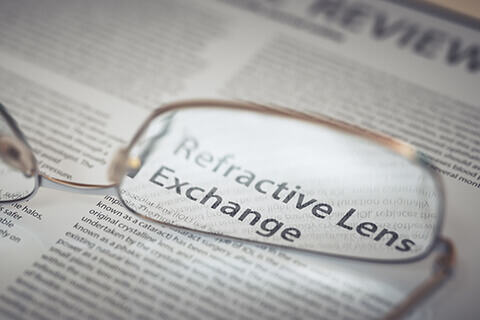Are you very nearsighted, have presbyopia, or have an abnormal cornea? You may have heard about a procedure called refractive lens exchange or RLE.
Consider RLE when solutions like LASIK, phakic IOL, or PRK aren’t recommended for you. Refractive lens surgery corrects refractive errors, resulting in clearer vision.
RLE can reduce or eliminate the need for glasses. What does the procedure entail, and is it the best surgery for your eyes?
What’s the procedure used to perform refractive lens exchange?
Refractive lens exchange is also called lens replacement surgery or clear lens extraction. RLE swaps your eye’s natural lens for an artificial lens.
The procedure is identical to cataract surgery, except in this case, the eye’s lens is clear.
Your new artificial lens will be one of two intraocular lens (IOL) options:
- Monofocal IOL – Provides clear vision at one distance, either near, intermediate, or far.
- Multifocal IOL – Provides clear vision at several distances.
Our eye doctor in the Hudson Valley can discuss which IOL is best for you after a comprehensive eye exam.
If you’re the right candidate for vision correction at our Kingston office, we’ll start by doing the procedure on one eye. One to two weeks later, we’ll finish the procedure on the second eye.
You won’t feel much discomfort or pain throughout the process because we use numbing drops on the eye. The entire surgery only takes about 15 minutes and is an outpatient procedure.
How long does it take to recover from lens replacement surgery?
You’ll most likely notice better vision immediately. It may be a few weeks before your vision reaches its maximum improvement.
Many patients experience symptoms like glare, halos, and discomfort. It’s also typical to experience blurred vision during the healing process.
You cannot drive yourself home after RLE. Make sure you have a friend or family member that can drive you home. The good news is most people can start driving a week after their procedure.
Your eye doctor will let you know when driving and other activities are safe for you to do.
How much does refractive lens exchange cost?
Refractive lens exchange costs an average of $3,000 to $5,000 per eye. Health insurance doesn’t usually cover RLE because it’s considered elective surgery.
You have options to make RLE more affordable, including using:
● Select financing options offered by our practice. Talk to our office and discuss the options that we have available for patients.
● Flexible Spending Accounts (FSA)
● Health Savings Accounts (HSA)
Will I need glasses after refractive lens exchange?

The biggest determiner of whether you’ll need to wear glasses is the type of IOL used. Because monofocal IOLs only give clear vision at one distance—usually far—you’ll need glasses for up-close work like computer use or reading.
People with multifocal IOLs have a broader range of vision and don’t usually wear glasses. For these patients, most rarely need to wear glasses or don’t need to use them full time.
Is refractive lens exchange safe?
Yes! RLE is a safe procedure with good or excellent results for nearly all patients. It also has little serious complications or side effects.
If you’re worried about RLE being safe, make sure to talk to your doctor. Ask any questions that you may have about the procedure. Discussion is the best way to ensure you’re comfortable before having RLE.
What are the possible risks of refractive lens exchange?
You have a higher risk of retinal detachment if you’re very nearsighted whether or not you have surgery. RLE increases your risk of retinal detachment within the first four years after your procedure.
As with all types of eye surgery, rare post-operative complications, like an infection damaging the retina or retinal detachment, can lead to a partial loss or permanent vision loss. Medication or other surgery successfully treats the vast majority of complications that arise.
Our eye doctor in Kingston will thoroughly vet and diagnose your eye condition. They will also assess your health history and risk factors to determine whether refractive lens exchange is the best option for you.
Being an ideal candidate reduces the risks associated with refractive lens exchange. This is the best way to ensure success with a procedure like RLE for our patients!
Dr. Cheema, our eye care specialist in the Hudson Valley and Kingston areas, will discuss all the benefits and potential risks of RLE. This is to ensure that you can make an informed decision about your eyesight and eye health.
Although refractive lens exchange is an excellent procedure, it’s not right for everyone.
Who is an ideal candidate for refractive lens exchange?
Good candidates for RLE have:
● No history of eye disease
● Stable vision for the six months before the procedure
● High nearsightedness or presbyopia
● Vision problems that can’t be corrected with alternatives like LASIK
The ideal candidate for RLE is in their forties and fifties. They have presbyopia and myopia with no signs of cataracts.
Some people with refractive errors of +6 or more may choose to get RLE as early as their 20s. If you have cataracts, our Kingston ophthalmologist can discuss your options for better vision.
Are you wondering if refractive lens exchange may be the right vision correction procedure for you? The only way to know for sure is to schedule an appointment at Cheema MD Eye Care in Kingston, NY!



